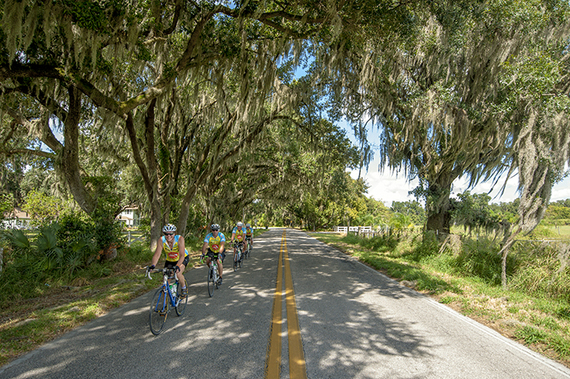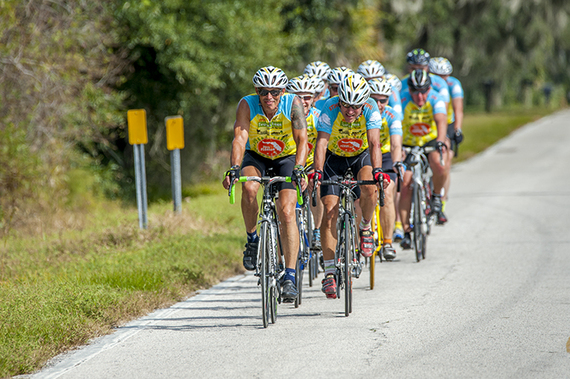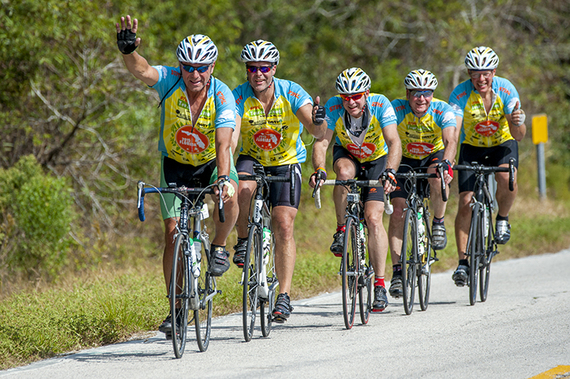Lessons learned during our 500-mile cycling journey to support tree research with the STIHL Tour des Trees
This year's 500-mile cycling event to raise money for trees, the STIHL Tour des Trees, started in Orlando, Fla. right in the middle of Walt Disney World. I arrived mid-day Saturday and couldn't wait to see my Tour comrades and catch up on a year's worth of life. This year has brought many personal changes for me: a new child and a new job with STIHL Inc. At one point, I was questioning whether I would be joining my friends on the Tour at all, but over the past week the yearly anticipation of the Tour's arrival steadily rose, and as I approached our launch hotel I was more than ready to see everyone.
I had the chance to address the riders at the opening dinner before we embarked on our busy week through the state of Florida. I tried to put into words how the STIHL Tour des Trees has impacted me and moreover how the money it raises for the TREE Fund and the research it enables impacts us. That morning, I watched my daughter give her first smile as she was held by her great-grandmother. Seeing a woman of 87 years hold a five-week-old made me think about the legacy we are leaving my daughter and her generation. The TREE Fund is an important part of ensuring we leave a legacy of strong, healthy trees to my daughter and beyond. The STIHL Tour des Trees, and the money we raise makes that necessary research possible.
I thought about the great naturalist John Muir and his plight to edify our government on the need to preserve vast swaths of land. One of the Tour speakers last year taught us that Muir had a life-changing conversation with a horticultural professor about the mechanics of trees and how well engineered they are, after which Muir set out on a lifelong quest to know nature and attend what he called "The University of Nature." He came here to Florida (Cedar Key to be exact), and I couldn't help but note the coincidence as we too are now traversing Florida on a pilgrimage for the trees. And as Muir did we are here to educate the public on the need for tree research. We are here to ensure that our urban forests get the protection and care they deserve. And what better legacy could we leave!
As the Tour started, the riding was brisk and the conversation good. The roads were smooth and the wind at our back. We planted a tree in Polk City and the head of the City Libraries greeted us along the way. We performed the standard tree blessing after properly planting a tree. You should never plant a tree too deep; the roots will suffocate. And away we went to Lakeland, Fla., home of Florida Southern University for lunch. We were greeted by our caterers the Wandering Fork, who provide the best fuel for riding this side of the Mississippi. We had the chance to see some of the buildings at Florida Southern that were designed by Frank Lloyd Wright; this is the largest collection of his buildings in one place. From here it was another 55 miles to our final destination for the day: Ruskin, Fla.
After 110 miles I wanted one thing only and that was cold water on my back and a place in the shade to relax. The sunset over Tampa Bay provided the perfect backdrop for dinner. We talked about the day's ride, compared efforts, smiled and enjoyed food and drink together.
After dinner, we had the opportunity to listen to Dr. Ed Gilman from the University of Florida talk about the impact of the TREE Fund grants toward his research. He said the average research project cost $60-70K. He showed us how he leveraged funds from industry partners and used the money to set up a research farm at the University of Florida. I was more impressed by the findings of his research and impact it had on the tree industry. His research has led to groundbreaking discoveries including how to prune a tree to minimize the strain on the main branch, one finding that changed the way nurseries grow trees in pots to maximize root growth. One of the most interesting studies involved comparing the strain on the roots of a nursery grown tree to a naturally grown tree under wind, which led to developing techniques that improve the roots of nursery grown trees and increase the strength of the tree in wind.
Having a chance to hear how our riding is providing support for these efforts is gratifying. It reiterates what we are doing and why we are cycling so many miles each day and fundraising each year. Sure, it doesn't hurt that we all like to ride and have become a big 'tree family,' but what we are really doing is securing the TREE Fund's legacy to help urban forests grow strong, healthy trees and give those who find passion in caring for them the help they need.
I invite you to learn more about the work of the TREE Fund at www.treefund.org.
All images courtesy Shutterjet/R. Jeanette Martin.




